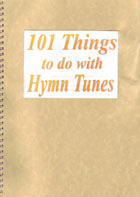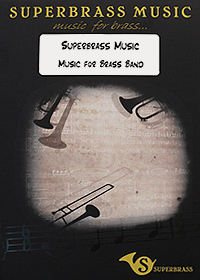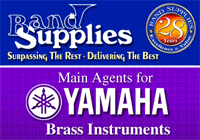101 Things to do with Hymn Tunes
30-Oct-2005Russell Gray
Published by: Jagrins Publications
Full Score and Band Parts
Price: 30.00 from 4BR
Have you ever wondered why the vast majority of brass band rehearsals start with the playing of hymn tunes?
A chance for those who have just run in with 30 seconds to spare before the conductor brings down his baton to get their lips into shape perhaps? Or because it gives the conductor the opportunity to hear which players have done a bit of home practice since the last time you rehearsed? Or because, brass bands since time immemorial have always played hymn tunes from the Red Books' to warm up'?
In reality it is perhaps it is a bit of all three. It does give the persistent late offender the chance to get their lip in before the rigours of test piece rehearsal, and it does give the conductor a sneaky chance to find out who has taken their instrument out of the case; and of course brass bands have always played hymn tunes to warm up, haven't they?
That though, shouldn't be the purpose, and this welcome and enjoyable publication from the current conductor of the National Champions of Great Britain and Jagrins Publications should ensure that in future, players, conductors and the bands themselves are made more aware of the importance of that opening ten minutes of rehearsal.
Productive rehearsal time
For those who have worked with Russell Gray will know, he attaches great importance to productive rehearsal time. If you only have two hours together twice a week, then every minute of that time must be utilised to the full. That 10 minutes or so spent at the beginning of every rehearsal is equally if not more important than the 10 minutes or so spent at the end running through a concert or contest piece. As he himself says in his introduction: "If you add those 10 15 minutes of time allocated two weeks before a contest, the non productive time escalates to approximately 90 135 minutes of wasted time". It is a sobering thought that by making sure you are well prepared as a band, could give you the benefit over 2 hours extra quality rehearsal time and that could be the difference between winning and losing.
The proof of this approach is in the contesting pudding so to speak and Russell Gray has become something of a gourmet cook in recent times. Just look at his record in 2005 and wonder why he is now so successful. He is of course a talented musician, but more than that, he works his chrotchets off in making sure his bands are as well prepared as they possibly can be. 101 Things to do with Hymn Tunes' is one of those major reasons why he has been so successful.
The book is aimed at conductors and bands who wish to improve their overall band skills. Those in the upper echelons of the contesting firmament may think they know better and don't need telling, but in recent years it has become self evident that bands (even the best bands) now struggle with the basics of brass band performing. When was the last time you heard a brass band play with a well balanced, tuneful timbre at a quiet dynamic and together?
The book will help and help even those who think they know better.
Six sections
Broken into six sections, it covers the differing aspects of hymn tune playing that are essential to good brass band playing: Rhythm and Articulation; Breath Control; Tone and Intonation; Dynamics; Concentration and The Last Chord. These are then brought together in a coda where specially arranged hymn tunes are used to utilise all those constituent parts.
It s not rocket science just a common sense; but then again how many bands and conductors lack that come a contest day?
Each section of the band and each individual instrument part is given something to do with the welcome addition of the percussion section. Everyone from soprano to triangle has a part to play, and this should ensure that the gang of percussion players are not left to gossip or read OK magazine amongst themselves for 10 minutes at the start of rehearsal. Percussion is nowadays such an integral part of a brass band, but one whose contribution to ensuring that an ensemble maintains rhythmic accuracy and precision is invariably overlooked. One of the great (and most obvious) problems with many lower section bands is that too often the percussion and the main ensemble do not listen to each other. How many performances have been spoilt by a drummer going one speed and the band going another?
Differing notation and complexity
All these things are addressed here by Russell Gray in a clear and precise manner. The opening section on rhythm and articulation makes the most of getting bands to play in time with clarity and precision. Differing notation combinations are used from simple chrotchets to nontuplets and in varying degrees of complexity. Get this right and your band will begin to play with compactness and precision that will win points at the next contest you go to for sure.
Breath control is covered by the use of a variety of cleverly constructed exercises and should help to eradicate one of the modern days curses of young players in particular the lack of proper breathing mechanics when playing.
This in turn leads to better intonation and tone, where Russell uses the voice as a means to show the player how to open' the sound and to provide a solid foundation to production. Get this right and the band will now sound fuller and warmer.
Dynamic contrast
Dynamic contrast is covered with the use of the simple but effective use of aural appreciation. Making sure an individual and a band know what a forte sounds like in relation to a mf or mp is fundamental to giving music colour, light and shade. You will very quickly come to realise why so many bands cannot make the difference between these subtle changes in dynamic variance with these exercises.
Concentration meanwhile is a modern curse of the brass band too many players of the MTV generation have concentration spans that would make a goldfish appear like Albert Einstein, whilst older players tend to forget the basics too often and rely on what they believe are the right things to do usually blowing even louder to cover weaker players and not being receptive to what they believe are new fangled' ideas. These few exercises should make sure those traits are nipped in the bud.
Finally, just when you thought all the hard work was done a band can ruin a performance by its very last note. Not many brass band test pieces end quietly, but so many end with a huge blast of sound that usually sends a shudder down the spine and bursts the blood vessels behind the eyes of the players, whilst sending the audience out of the hall clasping their eardrums. This should help to stop a performance from going peetong be it quietly or when the bellows from Hell are being blown.
With all this mastered...
With all this mastered, it can all be brought together in the selection of 10 well known hymns that can also be utilised in part or in full for each of the separate disciplines. These provide harmonic structure and the chance for the conductor to see and hear if the exercises are proving beneficial.
Russell Gray has produced a well thought out and cleverly constructed manual to help any band here. It is not condescending or over simplistic, but it is very effective and neatly arranged so that each discipline leads intelligently to the next with the final result a balanced sum of all its parts.
It has certainly worked for those bands Russell Gray has worked with, and it should prove to be beneficial for those he hasn't too. Hymn tune playing has been given a new lease of life.
Iwan Fox.



 »
» 





